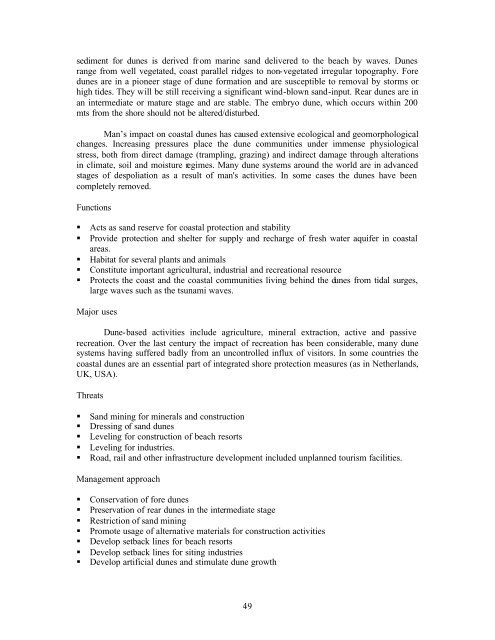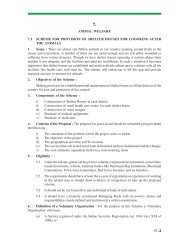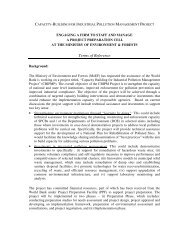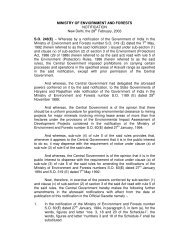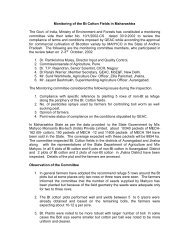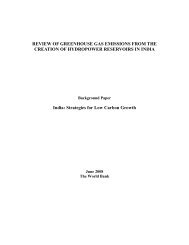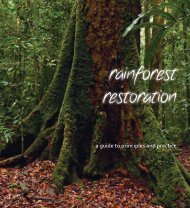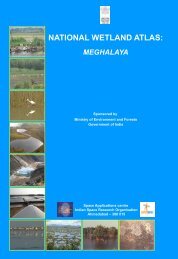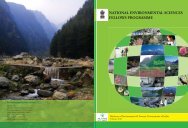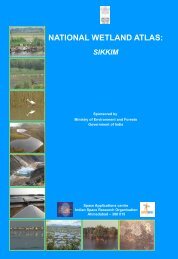pdf - Ministry of Environment and Forests
pdf - Ministry of Environment and Forests
pdf - Ministry of Environment and Forests
- TAGS
- ministry
- forests
- moef.nic.in
You also want an ePaper? Increase the reach of your titles
YUMPU automatically turns print PDFs into web optimized ePapers that Google loves.
sediment for dunes is derived fr om marine s<strong>and</strong> delivered to the beach by waves. Dunes<br />
range from well vegetated, coast parallel ridges to non-vegetated irregular topography. Fore<br />
dunes are in a pioneer stage <strong>of</strong> dune formation <strong>and</strong> are susceptible to removal by storms or<br />
high tides. They will be still receiving a significant wind-blown s<strong>and</strong>-input. Rear dunes are in<br />
an intermediate or mature stage <strong>and</strong> are stable. The embryo dune, which occurs within 200<br />
mts from the shore should not be altered/disturbed.<br />
Man’s impact on coastal dunes has caused extensive ecological <strong>and</strong> geomorphological<br />
changes. Increasing pressures place the dune communities under immense physiological<br />
stress, both from direct damage (trampling, grazing) <strong>and</strong> indirect damage through alterations<br />
in climate, soil <strong>and</strong> moisture regimes. Many dune systems around the world are in advanced<br />
stages <strong>of</strong> despoliation as a result <strong>of</strong> man's activities. In some cases the dunes have been<br />
completely removed.<br />
Functions<br />
� Acts as s<strong>and</strong> reserve for coastal protection <strong>and</strong> stability<br />
� Provide protection <strong>and</strong> shelter for supply <strong>and</strong> recharge <strong>of</strong> fresh water aquifer in coastal<br />
areas.<br />
� Habitat for several plants <strong>and</strong> animals<br />
� Constitute important agricultural, industrial <strong>and</strong> recreational resource<br />
� Protects the coast <strong>and</strong> the coastal communities living behind the dunes from tidal surges,<br />
large waves such as the tsunami waves.<br />
Major uses<br />
Dune-based activities include agriculture, mineral extraction, active <strong>and</strong> passive<br />
recreation. Over the last century the impact <strong>of</strong> recreation has been considerable, many dune<br />
systems having suffered badly from an uncontrolled influx <strong>of</strong> visitors. In some countries the<br />
coastal dunes are an essential part <strong>of</strong> integrated shore protection measures (as in Netherl<strong>and</strong>s,<br />
UK, USA).<br />
Threats<br />
� S<strong>and</strong> mining for minerals <strong>and</strong> construction<br />
� Dressing <strong>of</strong> s<strong>and</strong> dunes<br />
� Leveling for construction <strong>of</strong> beach resorts<br />
� Leveling for industries.<br />
� Road, rail <strong>and</strong> other infrastructure development included unplanned tourism facilities.<br />
Management approach<br />
� Conservation <strong>of</strong> fore dunes<br />
� Preservation <strong>of</strong> rear dunes in the intermediate stage<br />
� Restriction <strong>of</strong> s<strong>and</strong> mining<br />
� Promote usage <strong>of</strong> alternative materials for construction activities<br />
� Develop setback lines for beach resorts<br />
� Develop setback lines for siting industries<br />
� Develop artificial dunes <strong>and</strong> stimulate dune growth<br />
49


